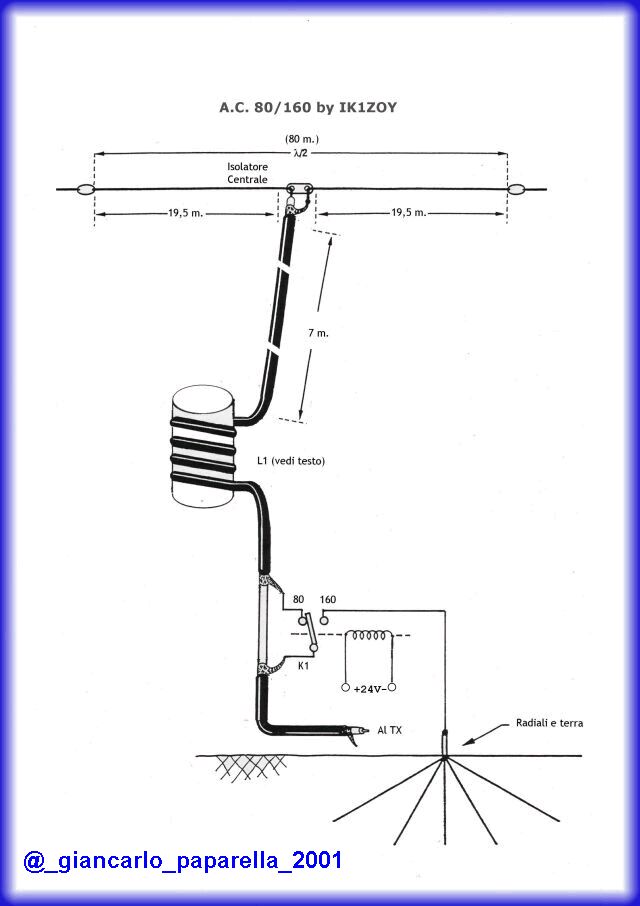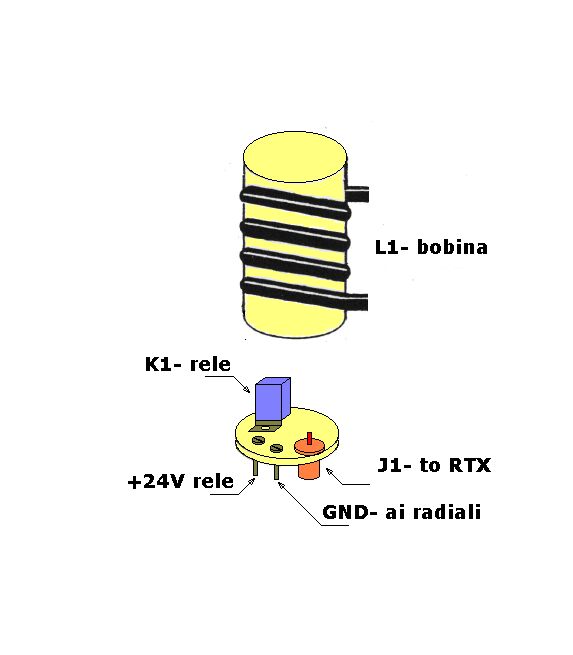“Switchable Antenna 80/160 m.” AC 80/160

Low bands of HF spectrum are incontrasted reign of wiring antennas.
Easy to make, cheap and low visible.
This last “ecological” character will be more important in the
future. A wiring antenna is low noticeable than a Yagi or a parabolic antenna.
The true problem is to find room where to install this long antennas.
I could install a ½wave dipole in the garden. It works well
even it’s not very high over the ground (6-10 m.) No news. The trafic on
160m. band was excluded.
The idea to work this interesting band was to use an arm of the dipole
and the vertical part of the feeder cable that together forms an L antenna.
To work, an L antenna need a ground reference as better as possible.
A lot of radials, metallic railing, ground leak point, idraulic pipes
are useful.
19,5 m. of ½ dipole and about 7 meter of the feeder cable vertical
portion, aren’t enough to tune the antenna on 160 m. The reactive capacitance
of this aerial was cancelled wrapping a part of the RG58 coaxial cable
on a cylindrical dielectric support of 100mm. diameter. This coil is comparable
to the bottom coil of a vertical antenna.
In my case were enough 9 links placed side by side. The winding is
extended on the cylindrical support for abt. 6cm.
The stocking of the cable must be interrupted at the end of the dummy
coil (TX side).
160 m. working mode (mode L)
The stocking of the cable, antenna side, shall be disconnected
The stocking of the cable, TX side, shall be connected to ground.(radials)
80 m. working mode (mode L)
The stocking of the cable, antenna side, and the stocking of the cable,
TX side, shall be connected together insulated from ground.
This switch is done by a relay. It can be a “not coaxial” one
because the low frequencies.
The matter is the quality of the component (insulation and contact
materials). I have used a surplus with 24vcc. Coil. The dipole shall be
without balun.
I hope that the drawing would be useful to understand the working principle
and the building technique.
Calibration
We assume that in 80m. the dipole is perfectly tuned. Check only that
the relay insertion doesn’t cause R.O.S. The coil don’t has influence on
the working apart a current symmetrical function.
The 160m. tuning shall be done reading the R.O.S.
Excite the relay and tune the coil looking for the right number of
turns.
To make it easy, wind some more turns on the cylindrical insulator
and stick it with tape.
Check the tuning frequency (lower than wanted). Roll down exceeding
turns to tune the antenna on 1,840Mhz.
The R.O.S. should be less than 1.5 for the whole assigned band. Like
this it’s possible to operate on 80 and 160 m. without antenna tuner with
low signal loss on the feeder line.
I would add a note related to the
device Coil/relais

Coil/Relay
I used a plastic can. I winded on the coaxial cable coil (see picture)
and inside of it I put the relay. It’s locked by a hanger to the cork.
Also the coaxial connector, the 24v end the ground screws are locked to
the cork.
After to have screwed the cork to the can the device will be waterproof.
It will be easily positioned near the ground line.
This antenna allowed me to get the 1° class. Italia single band
WPX SSB2000.
@_giancarlo_paparella_2001


